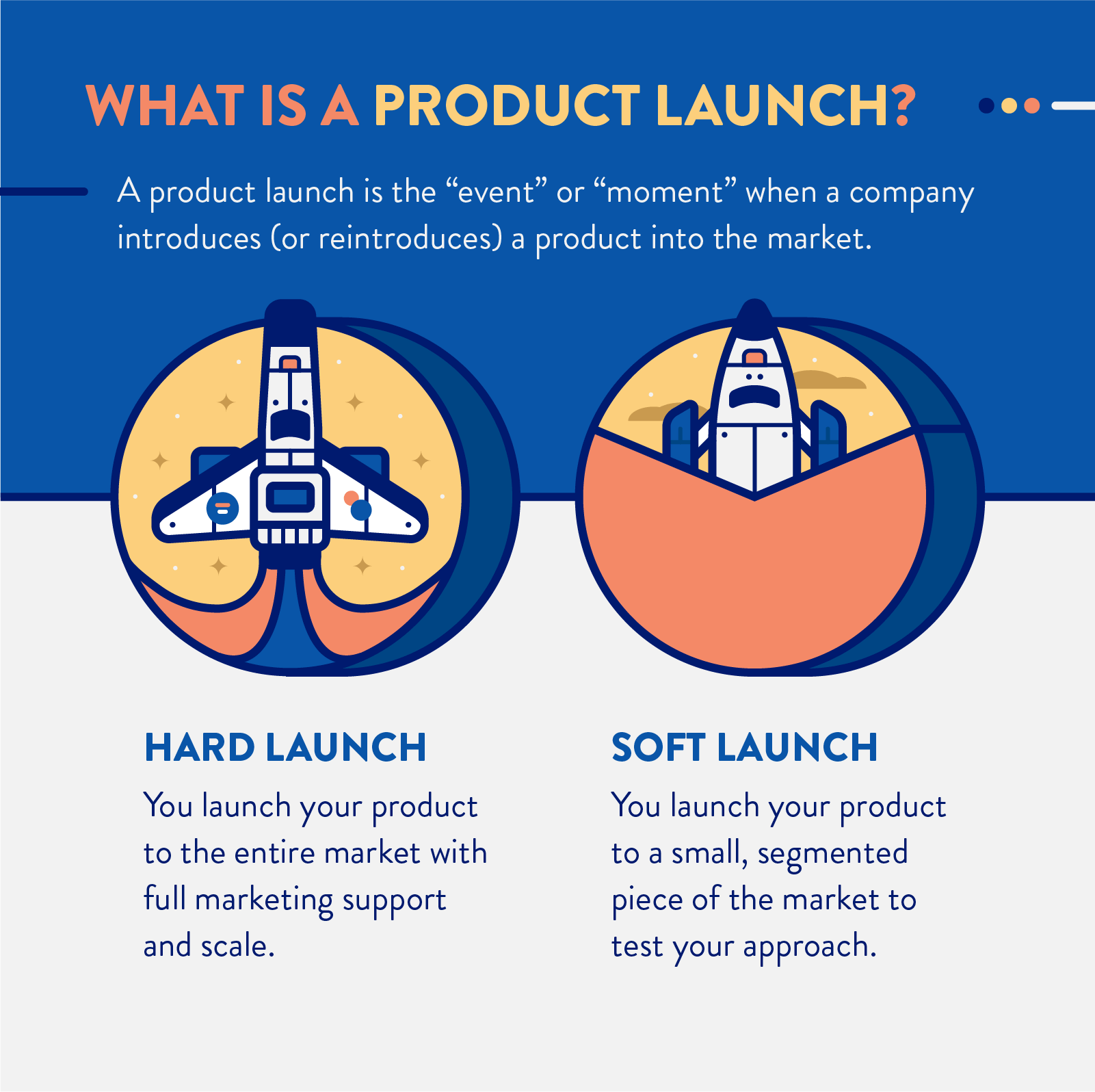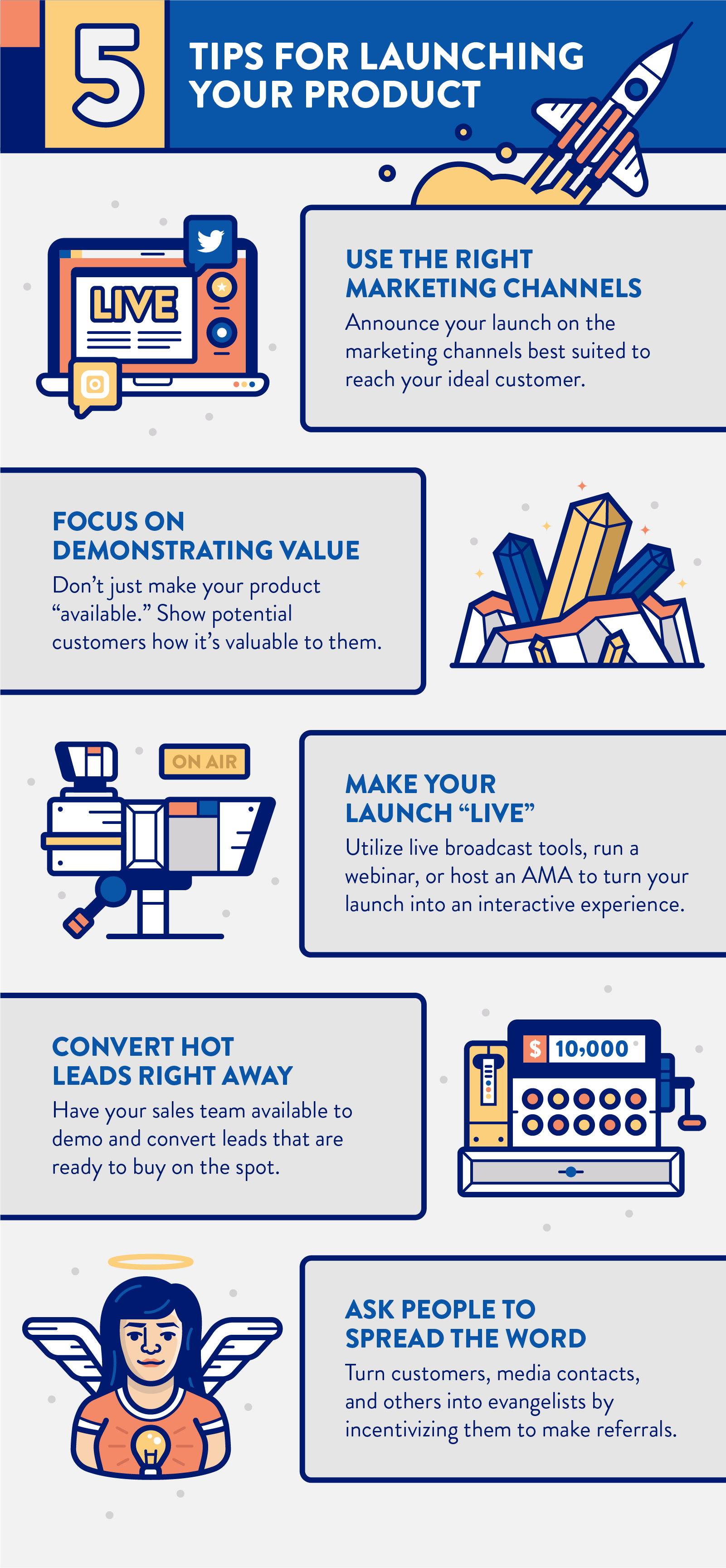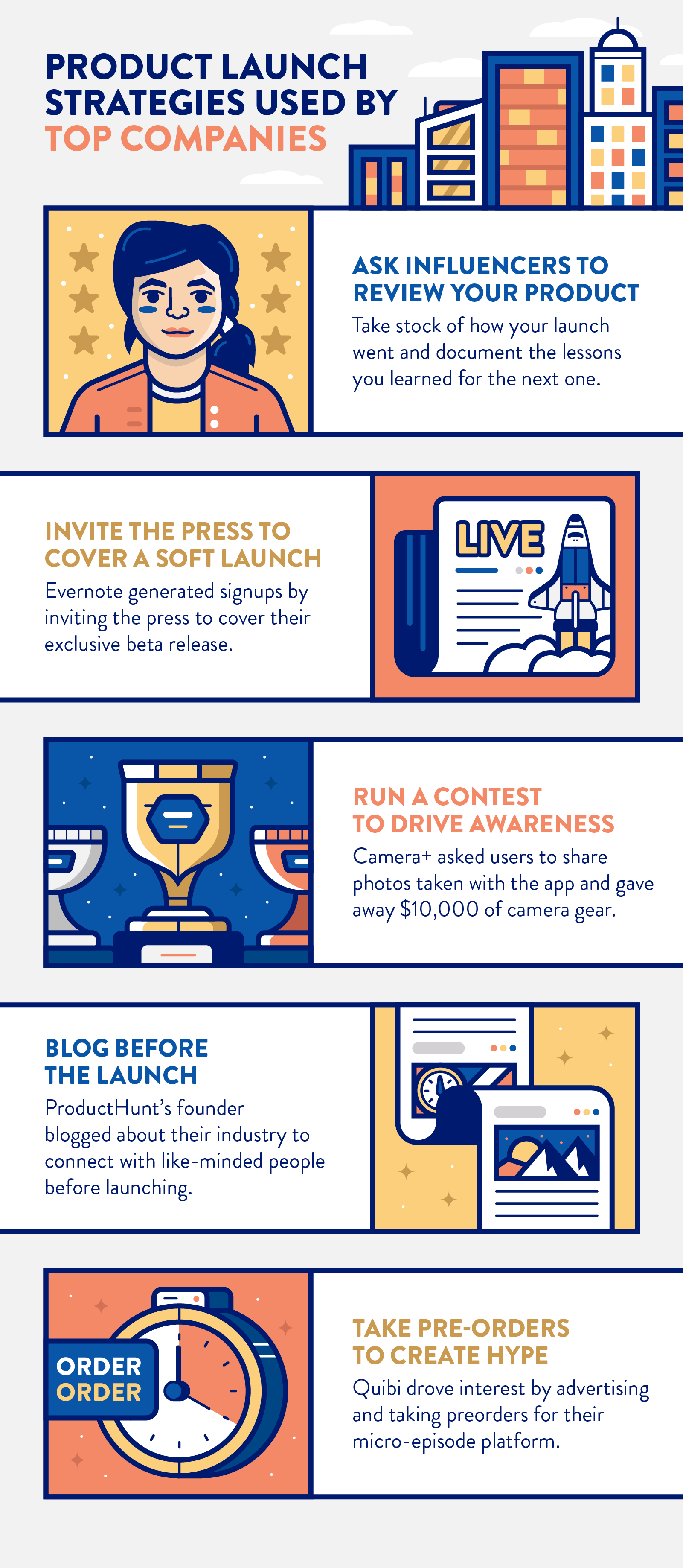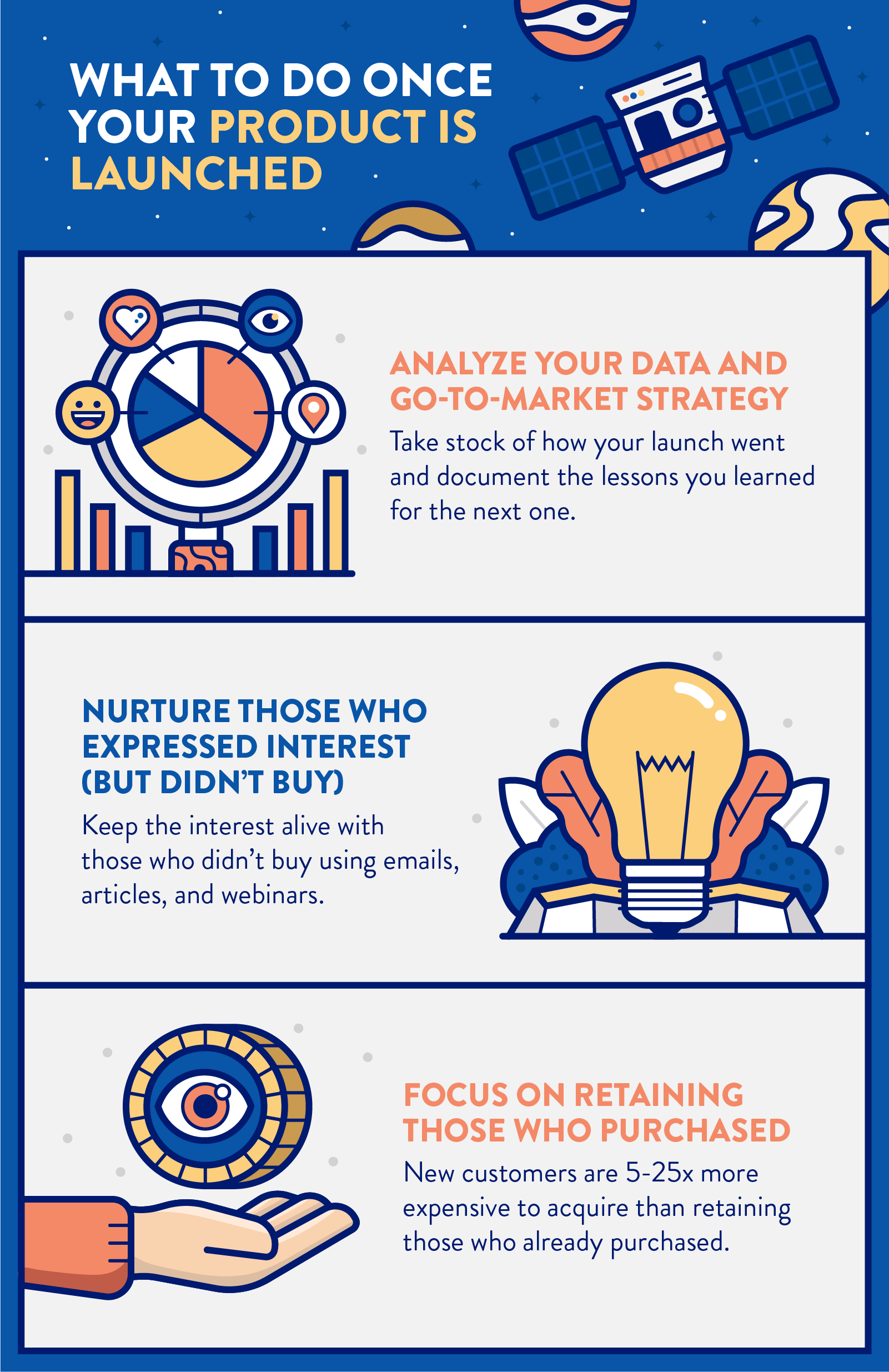Want to know something crazy?
Nearly 85% of the average consumer’s needs are covered by just 150 products, even though the average supermarket has over 40,000 in stock.1
It’s even more extreme for mobile apps — according to Forrester, smartphone users spend 88% of their screen time on just 5 apps, even though there are a whopping 4.2 million of them available between Google and Apple app stores.2
Simply put, no matter what new product you’re developing, it’s fair to say that getting people to adopt it will be difficult.
That’s why product launches are so important. Without a strong first impression, it will be hard to gain any kind of meaningful traction (not to mention sales).
Here is how to make sure your launch gets the attention of your prospective customers and your revenue stream flowing.
What is a Product Launch?
A product launch is the event or moment when a company introduces (or reintroduces) a product into the market. There are two common types of product launches that most companies use: hard launches and soft launches.
Hard launches are when you introduce your product to the entire public at once, with full marketing support.
Soft launches, on the other hand, are when you launch to a small, targeted segment of the market with specific messaging, usually with the goal of testing your approach.
Although it’s difficult to get consumers to pay attention to something new (or to change their habits), a strong product launch can break through their tunnel vision and kick-start interest — not to mention drive substantial revenue.
Launching a product happens in 3 stages: preparation, the launch itself, and post-launch.
Of these three, preparation is the most important to ensure that your launch is a success. According to The Belfort Group, a digital marketing and PR agency out of Boston, the number one reason product launches fail is lack of preparation.
Here’s how to launch your product step by step, starting with how to prepare for it.
How to Prepare For a Product Launch
Ever wondered how the comedians playing the biggest stages never seem to tell a dud joke? It’s not an accident — it’s because they prepare.
Comedians spend months (sometimes even years) testing and perfecting their jokes on smaller stages first. When they get to the big stage, they know each one is going to land because they’ve already told it hundreds of times.
This is the same approach you should take when preparing for your product launch.
First and foremost, before you launch anything, make sure your product is something people will actually buy. If your value proposition isn’t something the market wants, it doesn’t matter how good your launch is… it’s going to fall flat.
So validating your product and your marketing before you launch to the general public is the first step.
Many companies do this with a soft launch (or several) to a smaller, targeted, segment of customers, and using specific messaging. This allows them to gather feedback and data on their product and marketing approach — to get a feel for what’s working and what isn’t.
However, no matter how you launch, the key is making sure it’s a success is to do your homework before you do. Researching your market, customers, and competitors is essential to ensuring that your product and its market introduction is a hit.
Here are the 9 things you should research/do to help you knock it out of the park:
Product Launch Preparation In Summary: Don’t Guess
The most important part of preparing for a product launch is to take the guesswork out of it. Ruthlessly research and understand your ideal customers, the market you’re entering, and your closest competitors.
Keep in mind, there will likely be differences between what you learn from your research and reality. So ideally, you’ll want to test what you learned to make sure it was accurate. This is why a soft launch or a beta version is helpful.
Once you’ve done that, you can refine your approach and scale it up to a full hard launch knowing with confidence that it will be a success.
How to Launch Your Product
Launch preparation can take months or even years. But the launch itself often comes and goes in less than a week.
The good news is, if you’ve done the right prep work beforehand, the launch should be a hit.
That said, there are certain elements that are proven to help you make the most out of launch week. Here are 5 to incorporate into yours:
Focus on Demonstrating Value
It’s tempting to want to show people all the features and amazing things your product can do when you launch it. However, it’s better to focus on demonstrating the benefits prospective customers will experience and the results they’ll see from using your product instead.
Unfortunately, there is no “one size fits all” approach to this — it really depends on your product and your customers.
This is why the research you do during your product launch preparation is so important.
If you understand your customers and what matters to them, formulating a launch strategy that bridges the gap between what they desire and what your product provides is much more straightforward.
Stick to the Best Marketing Channels
If you’ve done your research, you know where your ideal customer is best suited to be reached. But when the launch arrives, it’s often tempting to “spread the word everywhere.”
Resist the urge to do so, as it will only dilute the excitement you create from the channels where you’re actually reaching your target customers.
Think about it like this: if all of the feedback from your product launch is positive, it’s going to echo across the market and continue to drive further interest. But if you have some channels that are “meh” about your product, it’s going to send customers who are on the fence mixed messages.
Focus on driving maximum hype with early adopters who will find your product most valuable and let those who are on the fence see the results. Scale up from there.
Turn Your Launch Into a “Live” Event
According to The 6 Principles of Persuasion by Robert Cialdini, people are more likely to buy from those that they connect with. In this case, connection means those that they identify with or simply like.
That’s why incorporating an “in-person” element into your launch is an important strategy to ensure its success. Giving the customers you’re trying to reach a chance to interact with the people behind your product can go a long way towards creating that connection.
Social networks like Facebook, Instagram, and Reddit have live broadcast tools that can help you do this digitally if a physical event doesn’t make sense for your product. Webinars are also an effective tool for doing this in some industries.
Incentivize Referrals
Most people are friends with people who share the same interests and values.3 So a great way to make launch day a success is to use your early adopters’ networks to drive interest.
Offer a reward for making a referral, or run a contest that they can only enter by sharing something on social media. If you give them a reason to tell their friends, it amplifies the work you’ve done to launch your product.
Get Your Sales Team Ready
The ultimate goal of your product launch is to drive sales. So if you have a sales team, make sure they are standing by to convert hot leads right away. Staff up so that you’re ready to capitalize on the number of leads that come in!
Product Launch Strategies Used by Top Companies
Whether you’re looking for inspiring app launch strategies or simply need ideas to get your launch ready, we’re presenting five of the most successful product launches and the strategies behind them:
Leverage Influencers and the Press
Instagram has one of the most successful product launches in history.
Their primary strategy? Asking influencers and journalists in the tech space to review their app before it had officially launched — most notably Twitter founder Jack Dorsey, who posted pictures of the app on his own platform.
This approach generated a lot of interest before the app was officially available, driving over 10,000 downloads just in the first few hours after launch and over 100,000 in the first week.4
However, another key to their success was timing.
Instagram made the decision to launch their app just after the release of the new iPhone 4, which featured a new camera and screen. This turned out to be a perfect combination that helped users get the most out of their app and their new device simultaneously.
Run a Contest to Drive Referrals
In addition to creating interest on social media before their launch, Camera+ created a contest that utilized one of their app’s key, differentiating features to drive referrals.
Since their app offered the ability to upload pictures directly to social media (something no other camera app had at the time), they ran a photo contest that required new users to post pictures they made with the app on social media and gave away $10,000 worth of camera equipment to the winners.
This approach kickstarted their business, earning them $2+ million in revenue (on a 99¢ app) in just their first year.5
Build Your Audience First
ProductHunt’s CEO Ryan Hoover didn’t set out to release a product or even build a platform. He was just trying to solve one of his own problems (finding new products) and had friends that were struggling with the same thing.
So he started with a weekly email to his friends writing about the problem and providing a solution (a list of cool, new products that had the potential to be game-changing).
That email list grew quickly and when he launched his site, he already had a group of people who were interested.6
What to Do After You’ve Launched Your Product
Congrats, you did it! Pop the bubbly and celebrate! Just keep in mind your work isn’t finished simply because the launch is complete.
Not only did your launch generate a lot of sales, but it also generated a lot of data and interest within the market as well. And you’ll want to make sure you capitalize on both of these.
Here’s how:
First things first, take a second (two even) to dissect what went well and what didn’t. Dig through your analytics to understand your marketing success and look at your entire launch funnel to see where improvements could be made.
Next, keep in mind that your launch likely generated a lot of interest among people who may not have been ready to buy just yet. So it’s important to keep those people close: nurture them through your funnel and serve them retargeting ads to draw them back in.
Email marketing, content, videos, and more are great ways to stay top of mind with this group. Just make sure that what you send them is valuable.
Finally (and probably most importantly), turn your focus towards those who did buy.
Acquiring new customers is 5x-25x more expensive than retaining existing ones. Furthermore, just a 5% increase in customer retention rate can drive anywhere from 25% to 95% greater profitability.7
So once the launch is complete, continue to delight and engage those who have already purchased your app with personalized content and messaging.
Focus on Product-Market Fit
Product launches are successful when the market you launch to is a perfect fit. The goal when you’re preparing to launch is to find it before you do so. We’ve created a resource to help. Learn more about solving the product-market fit puzzle.

The Psychology of Insanely Addictive Apps
Subharun Mukherjee 
Heads Cross-Functional Marketing.Expert in SaaS Product Marketing, CX & GTM strategies.
Free Customer Engagement Guides
Join our newsletter for actionable tips and proven strategies to grow your business and engage your customers.














































